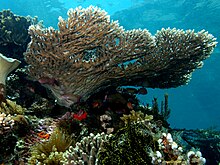User:L.schlieman/sandbox
Marine Spatial Planning[edit]
Marine spatial planning in Indonesia[edit]

Indonesia is the world's largest island nation, with a population of 275,122,131 and a coastline of over 54,716 km.[1] It is located within the Lesser Sunda Region of the Coral Triangle, the most biodiverse marine region in the world.[2] The country's large population places pressure on the marine habitats, even in sparsely populated areas. Destructive fishing practices, poaching of cetaceans and turtles, and pollution threaten the diverse and unique coral and pelagic habitats. The Savu Sea is unique, even within the Coral Triangle, for its oceanographic features and biodiversity.[3] To protect this region from human and other threats, the Indonesian government created the 3.5 million hectare Savu Sea National Marine Park. An initial assessment of the area of the proposed park identified critical threats, local human uses of the area, and an effective strategy for addressing the conflicts between them. Marine spatial planning was used to divide the area into four types of zoning: a core zone restricted to education and research, an area for sustainable fisheries, a zone designated for marine tourism, and a further-subdivided "others" zone.[4] The Savu Sea Marine National Park is now one of the largest marine protected area in Southeast Asia.[5]
Marine spatial planning in Rhode Island[edit]
Rhode Island is the first state to have a marine spatial plan formally approved for use by the federal government as an element of the state-level Coastal Management Program. The Ocean Special Area Management Plan (Ocean SAMP) adopts ecosystem-based approach to marine spatial planning. Its creation was prompted by the need to identify suitable sites for offshore windmills.[6] Wind turbine development was opposed by local commercial fishermen.[7] Conflict between commercial fishermen and wind turbine developers once again surfaced with the proposal of the Vineyard Wind wind turbine development off the coast of Massachusetts. The Bureau of Ocean and Environmental Management (BOEM) issued permits to Vineyard Wind in Massachusetts state waters which abut those of Rhode Island and is the site of commercial fishing by Rhode Island-based fishermen. Conflict between these two entities was minimized through the federal consistency provision of the Coastal Zone Management Act (CZMA). The federal consistency provision requires federal agencies conducting activities that will affect the coastal zone to do so in a manner consistent with the state's coastal management plan developed and implemented under the CZMA.[8] The original plan for Vineyard Wind's turbines did not fit within the requirements of Ocean Samp. Amendments were proposed to the location and number of turbines and these were accepted.[9]
 | This is a user sandbox of L.schlieman. You can use it for testing or practicing edits. This is not the sandbox where you should draft your assigned article for a dashboard.wikiedu.org course. To find the right sandbox for your assignment, visit your Dashboard course page and follow the Sandbox Draft link for your assigned article in the My Articles section. |
- ^ "Indonesia - The World Factbook". www.cia.gov. Retrieved 2021-04-25.
- ^ Cruz-Trinidad, Annabelle; Aliño, Porfirio M.; Geronimo, Rollan C.; Cabral, Reniel B. (2014-02-12). "Linking Food Security with Coral Reefs and Fisheries in the Coral Triangle". Coastal Management. 42 (2): 160–182. doi:10.1080/08920753.2014.877761. ISSN 0892-0753.
- ^ "Indonesia – Savu Sea | Marine Planning". marineplanning.org. Retrieved 2021-04-26.
- ^ Alexander, Karen (2019). Conflicts over Marine and Coastal Common Resources. pp. 127–128. ISBN 978-0367785376.
- ^ Perdanahardja, Glaudy; Lionata (2017). "Nine Years in Lesser Sunda" (PDF). The Nature Conservancy.
{{cite web}}: CS1 maint: url-status (link) - ^ Olson, Stephen B.; McCann, Jennifer H. (March 2014). "The State of Rhode Island's pioneering marine spatial plan". Marine Policy. 45: 26–38.
- ^ "Recreational and Commercial Fishermen View the Block Island Wind Farm Through a Different Lens". Rhode Island Sea Grant. 2019-01-10. Retrieved 2021-04-26.
- ^ "Section 650-RICR-20-00-1.4 - Federal Consistency, 650-20-00 R.I. Code R. § 1.4 | Casetext Search + Citator". casetext.com. Retrieved 2021-04-26.
- ^ "PROPOSED AMENDMENT TO RHODE ISLAND'S GEOGRAPHIC LOCATION DESCRIPTION" (PDF). July 19, 2018.
{{cite web}}: CS1 maint: url-status (link)
